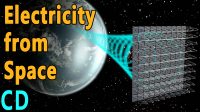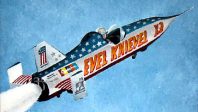The story of the NASA’s million $ space pen and the soviet pencils has become one of the enduring tales from the space race which still floats around the internet today and goes a bit like this.
During the 1960’s as NASA was sending the first men in the space, they realise that pens don’t work in zero gravity, so they spent years and millions of tax payer dollars to develop one that did. Meanwhile, in the Soviet Union, the cosmonauts simply used pencils.
The moral of the story to many is that NASA was a wasteful government organisation that would be giving your hard earned TAX dollars to some greedy contractors charging sky high prices for a seemingly trivial object whereas the enemy, the Soviets, where common sense and practical.
But the story is a myth, however like all good myths it’s based on facts, facts which over time like Chinese whispers end up as grossly exaggerated stories which then are taken at face value and purport to be the real facts.
The true story of the “Space Pen” is a bit more down to earth and starts with a sandwich on the Gemini 3 mission of March 23rd, 1965.
The crew of the flight were Gus Grissom and John Young. After the mission, it came to light that John Young had smuggled a sandwich on board in his spacesuit pocket.
Although it had been allowed by the director of flight operations, it was frowned upon by the flight surgeon because when they took bites out of the two day old sandwich in orbit, the crumbs floated around the cabin in microgravity and that these could get into the electronics and cause a problem.
At the time, the astronauts had an exclusive deal with “Life” magazine and some thought that they had planned little stunts like this, so as to reveal them in upcoming articles. In the earlier Mercury missions, it had been commonplace for non-flight items to have been taken on board missions.
When it was then discovered that the two mechanical pencils the crew were using, cost $128.84 each ($986 today) and that NASA had bought 34 of them for a total of $4,382.50, the equivalent of $33,700 in 2017 prices, the press had a field day and there was a public outcry.
It turned out that the actual pencils cost $1.75 each but then they had custom made housings so that the crew could hold and write with them whilst wearing their thick space suit gloves and it was the R&D and manufacturing cost of these housings which was where the bulk of the money had really gone.
The issue here is that people might not know what a flight computer or a rocket engine costs but when they see a pencil costing $128, they might well think what else have unscrupulous contractors been over charging for.
After an investigation, as to what was being carried on to missions, it also turned out that they also had on board four Japanese Pentel pencils which cost $0.49c each, something NASA definitely didn’t want to be known about when they flew alongside the $128 American versions.
During the mid-1960’s, Paul Fisher, inventor and owner of the Fisher Pen Company patented what he called the “space pen”.
Fisher knew of the issues with the NASA pencils and had the idea of making a pen that would work in space. The Space pen had a cartridge pressurised with nitrogen and that used a special gel ink that became liquid when the ballpoint rotated against the gel. It could write at any angle, on almost any surface, in a vacuum, even underwater and worked in temperatures from -46C to +71C.
However, he didn’t have any official backing, nor was he contracted by NASA, it was just his idea to make the perfect pen and he funded it privately by his company to the tune of a reportedly $1 million, how true that figure was, might be up for question but it’s where the $million price tag comes from.
Fisher knew that space was the hot topic at the time, so with a bit of creative writing copy he advertised it as “Space pen by Fisher and it writes in space”.
This was something which NASA objected to when he tried to get a copy of the history of the pens development reviewed by NASA, something which he had managed to get into the Congressional record of March 1966.
He had also submitted a version of the pen known as the “AG-7” or Anti-gravity 7 for consideration to be used on the upcoming Apollo missions.
After the Gemini pencil debacle a few years earlier and the need to make sure that everything in the small cabin and high oxygen content recirculated air system was safe, NASA had clamped down on what could be taken on to missions.
So, wood shavings and graphite of normal pencils, inks from pens and other things which could be floating around in micro gravity were now considered to a hazard to both the open switches in the electrics and also the crew, as well as a fire hazard in an oxygen rich atmosphere after the Apollo 1 fire disaster.
NASA eventually opted to use the sealed AG-7 Fisher pens in the Apollo missions alongside felt tip pens and ordered 400 of them.
After a bit of head stretching at ground control, they advised that they use the tip of the AG-7 pen to flip the switch mechanism, which they did and the crew took off successfully.
As for the Soviets, they moved away from using pencils because the tips would break off and float around the cabin, so for a while they used grease or wax pencils on plastic slates but these were not as durable as ink and they still had to dispose of the pencils paper wrapping safely.
So did an AG-7 space pen save Apollo 11 after a switch lever to arm the ascent engine broke off when it was caught on the Buzz Aldrin’s space suit as he was getting back in the lander?..
Yes and no, he did flip circuit breaker with the tip of the pen but engineers had already found a way to bypass the switch in a more reliable way.
In 1969 the Soviets also bought the 100 fisher space pens and 1000 ink cartridges and the Space pen went on to be a staple of not only the space missions but many other industries too.
So was the American space pen better than a Soviet pencil, yes it was. Did it cost NASA a million dollars?, no it didn’t. Both NASA and the soviets got a bulk buy discounted price of $6 each.





